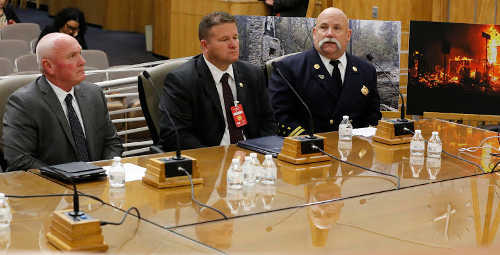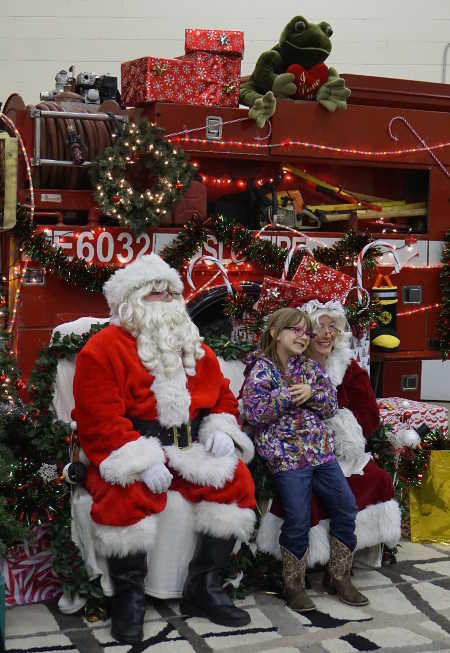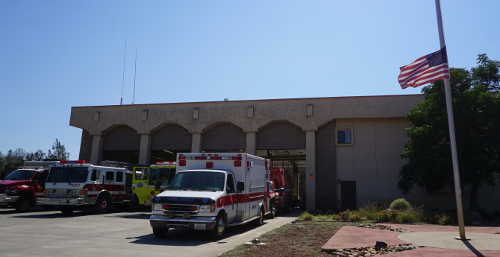
SOUTH LAKE COUNTY, Calif. – The year 2015 will be remembered by many for the personal destruction it brought in the form of the Valley fire.
Tens of thousands of people were driven from their homes, thousands were left homeless.
The southern Lake County landscape – known for its pine forests as well as oak-studded vistas – was drastically changed and is unlikely to recover fully within the lifetimes of many those who loved it.
The 2015 wildland fire season and the damage it did across Northern California as a whole is likely to be remembered for one horrifying fact, according to Los Angeles-based Fire Family Foundation Executive Director Robin McCarthy.
“This is the largest loss of property since the 1906 earthquake for firefighters,” she told Lake County News.
McCarthy said that, altogether, 33 firefighters across Northern California lost their homes while they were simply out doing their jobs on the lines of the Butte and Valley fires.
Of those firefighters, 16 were in the South Lake County District. Dan McCabe, president of the South Lake County Firefighters Association, said that number included current or past South Lake County Fire and Cal Fire personnel – both paid and volunteer, as well as a board member – and their families.
The third most damaging wildland fire in California's history, the fire began on Saturday, Sept. 12, 2015, on Highway Valley Road in Cobb and peaked seven days later, according to Cal Fire.
It burned approximately 76,067 acres, primarily in Lake County, but with some of that acreage also in neighboring Napa and Sonoma counties.
The fire resulted in four confirmed fatalities, with authorities unable to confirm if a fifth man who disappeared during the fire also ultimately perished in it.
There also were four significant firefighter injuries when Cal Fire Copter 104's crews were caught in a burn over within the first hour of the fire. Cal Fire said one of those firefighters' injuries were serious enough that he did not return to work.
Cal Fire said the effort to fight the fire involved 4,400 personnel, 437 fire engines, 22 helicopters, 56 bulldozers, two airtankers, 100 hand crews, 75 water tenders, and more than 200 cooperating local government and volunteer agencies assisting from throughout the nation.
Based on Cal Fire's final damage assessment on the fire, released in January, the fire destroyed approximately 1,955 structures, including 1,308 residences, 66 commercial buildings, 558 outbuildings and 23 other structures. Another 93 structures were damaged.
All but eight of the destroyed or damaged structures were in Lake County. Two were in Napa and six in Sonoma, Cal Fire said.
This summer, Cal Fire released its final determination that the fire had been sparked by faulty wiring to a hot tub at a Cobb residence.
Cal Fire reported that it paid $59 million out of its emergency fund to fight the fire, with the state seeking additional assistance from the Federal Emergency Management Agency.
State Sen. Mike McGuire said the fire resulted in $1.2 billion in damage in Lake County alone.
More than 50 percent of acres burned in the State Responsibility Area in 2015 were in Lake County, according to Cal Fire.
And in 2015, the South Lake County Fire Protection District – one of the state’s largest fire districts by land area, according to district Board President Jim Comisky – was hit especially hard.
Cal Fire said 63 percent of the district's footprint burned between the Jerusalem and Valley fires in 2015.
As a result, the men and women of the South Lake County Fire Protection District would suffer devastating losses that mirrored those endured by the community members they serve.
Help from the state, Fire Family Foundation, local friends
The Fire Family Foundation became a nonprofit in 2008, and is the charitable hand of the Firefighters First Credit Union, headquartered in Los Angeles but covering the entire state of California, McCarthy said.
She explained that it was formed in response to needs that arose from the Sept. 11, 2001, terrorist attack.
Firefighters, she explained, are part of a larger brotherhood.
The credit union had created a fund to help the firefighters' families impacted by the attack, and ultimately led to a desire to create a foundation to provide financial assistance to departments, firefighters and their families impacted by disaster.
When the Valley fire first hit early last September, the foundation decided to open a relief fund specifically for Middletown, and issued a challenge by the California Credit Union League, McCarthy said.
The foundation also partnered with Redwood Credit Union and Mendo Lake Credit Union, which already were part of fire-related fundraising efforts. “They know the community much better than we do,” she said.
Ultimately, the foundation – in partnership with the California Credit Union League – provided $167,800 for care, counseling, housing and community support to assist children and families in recovering from the fire, McCarthy said.
Another piece of the funding, about $18,000, went specifically to help firefighters and came about through a separate fund called “Helping Firefighters Heal” through which Northern California fire departments could adopt the impacted firefighters, McCarthy said.
She said that funding effort – a partnership of the Fire Family Foundation and the Oakland Firefighters Random Acts – determined immediate needs and provided up to $1,000 per impacted firefighter.
McCarthy said the foundation doesn’t provide cash, but offered gift cards to cover needs such as appliances, fencing, tools and, in one firefighters’ case, paid for training because of loss of training paperwork.
In some cases, she said fire departments that adopted the firefighters who lost homes went out shopping and delivered the items to the individuals they were designated to help.
“It really varied depending on the individuals and where they were,” she said.
McCarthy added, “This is literally what we do.”
Among the foundation's efforts on the ground in Lake County, it donated money to help rebuild local youth sports programs, including the Middletown Colts, soccer boosters, Clear Lake Youth Soccer, Middletown Youth Little League and Middletown Youth Basketball, McCarthy said.
She said the foundation also donated funds to help with South Lake County Fire's Christmas event, which handed out toys to hundreds of children in December, and hosted Santa and Mrs. Claus.
The foundation also provided funding to repair the Pine Summit Recreation and Social Club, gave funds to support school garden programs – “dirty therapy” for children – throughout the burn area as well as money to help the Cobb Mountain Lions Club Relief Center.
“They've been a key player,” Cal Fire Division Chief Greg Bertelli said of the Fire Family Foundation.
There also was an effort by other local firefighters to assist.
In October, the Northshore Fire Association held a pancake breakfast benefit for firefighters who lost homes in the Valley fire.
That event may well have been the most successful pancake breakfast in memory. Northshore Fire Chief Jay Beristianos said it generated $10,000 to assist the impacted firefighters.

The toll on employees
Bertelli was a battalion chief the day he responded to the Valley fire last year. Since then he’s been promoted to division chief, and also is South Lake County Fire’s chief.
He said the district’s employees who were affected are moving forward with their lives. There is a fair amount of turnover among the district’s professional firefighters, with some moving on to other jobs. But he’s not aware of anyone leaving strictly due to the fire.
Bertelli acknowledged, “Everybody’s a little shell-shocked.”
Add to that, they’re working longer hours in response to the area’s wildland fires.
“And the anticipation of another one, it does hang over people's heads,” Bertelli said.
It was tough enough just recovering from the Valley fire, but so see the Clayton fire impact another community so heavily, and so soon afterward, was difficult, he said.
The main thing, he said, is the health and welfare of the district’s employees and their families.
Bertelli said fire seasons are getting longer every year, and it could be another few months before the 2016 fire season is over. Over the last few years, fire seasons have extended deeper into the fall months, finally being called closed at the start of December.
The months of September and October also pose particular challenges, as they’re when catastrophic fires normally occur, Bertelli said.
There are concerns that the winter may not have enough wet weather. “I don't see any rain in the forecast,” said Bertelli, noting that Northern California will need a lot of rain to get onto the ground to alleviate its fire conditions.
Amidst the concerns of fires here in Lake County, Bertelli said the district’s Cal Fire firefighters, crews, engines and bulldozers have continued to travel to other areas to work on major incidents, such as the Sobranes, Gap and Saddle fires.
“We constantly are moving resources around,” he said.
Financial realities and project planning
South Lake County Fire contracts with Cal Fire each year for service at a cost of $2.2 million. However, with 70 percent of its property tax dollars lost primarily due to the Valley fire, officials said it has required financial assistance.
McGuire and Assemblyman Bill Dodd obtained funds to backfill those obligations from the time of the fire through June, at which time Gov. Jerry Brown's new budget included another $2.2 million to cover the district's budget through the end of June 2017.
“There is no way the district can afford this contract, which is why the state is stepping in to continue to ensure there is not a blip in coverage,” McGuire told Lake County News.
In addition, McGuire and Dodd managed to get another $1.3 million included in the state's 2016-17 budget to help the county cover lost revenue from property, sales and bed tax lost as a result of the Valley fire.
“The full financial impact hasn’t yet been felt,” Bertelli said of the Valley fire, explaining that the district is still trying to project out the budgetary impacts.
Comisky, himself a firefighter for 38 years, said one of the immediate impacts is that the district’s call volume dropped significantly in the fire’s wake.
He said the district is now working on a strategic plan to assess its future and what it will require to meet the needs of its community in the years to come.
Part of the focus is on fiscal responsibility – including putting as much money into reserves as possible – and creative thinking. Both will be needed as Comisky does not expect a third year of funding from the state to cover the Cal Fire contract after having received two years of that support.
Comisky estimated the district’s annual budget totals between $2.6 million and $2.7 million. Of that amount, $2.4 million annually goes to the contract with Cal Fire.
In March, Comisky – along with Sheriff Brian Martin and Comisky’s high school classmate and longtime friend, Board of Supervisors Chair Rob Brown – testified before a state legislative committee on behalf of fire relief assistance legislation put forward by McGuire and Dodd seeking assistance for the county.
Without Cal Fire, the district couldn’t on its own afford the level of service currently offered to the community, he said.
Rob Bostock, the board’s vice president, said that along with Comisky he works to keep an eye on the money.
At the open house the district and Cal Fire held on Sept. 11 to mark the fire’s one-year anniversary, Bostock said that dollars and cents “is the issue.”
Beyond that, speaking of his community of Cobb, he believes people will rebuild because it’s a special place.
The district’s roadmap for the days to come includes creating a strategic plan and finding sustainable funding, Comisky said.
While he said the situation is a “scary thing,” he added, “I think we’re going to be OK.”
In the short-term, as rebuilding is under way, he said the district has brought on Chris Vallerga to fulfill fire captain and fire marshal duties. Vallerga will be devoted full-time to signing off permits for new construction.
“The codes have changed significantly,” said Comisky, so having a staffer devoted to working with the community to meet those changes is critical.
Comisky also wants to push forward on a plan for emergency sirens – a total of seven in the district’s coverage area – which will cost more than $184,000.
Sirens – one each – would be located in Loch Lomond, Cobb, Anderson Springs and Middletown, with three in HVL, he said.
Cal Fire Battalion Chief Mike Wink said Loch Lomond has siren equipment that needs to be replaced.
An overarching plan that’s under way calls for a total of 28 sirens all over the county, according to Supervisor Rob Brown.
“We hear loud and clear from the community, this is what we want,” Comisky said of the siren project.
There used to be sirens on stations to notify volunteers. “We quit using them years ago,” said Comisky.
A question still to be answered is how many of the burned structures will be rebuilt.
For Comisky, the hope is that the community’s population won’t just return but will grow beyond what it was before.
Bertelli said one of the key lessons to emerge from the fire is relevant to firefighters and everyday community members alike.
Whether in business or in one’s personal life, “We're all vulnerable to the effects of fire.”
Email Elizabeth Larson at


 How to resolve AdBlock issue?
How to resolve AdBlock issue? 



